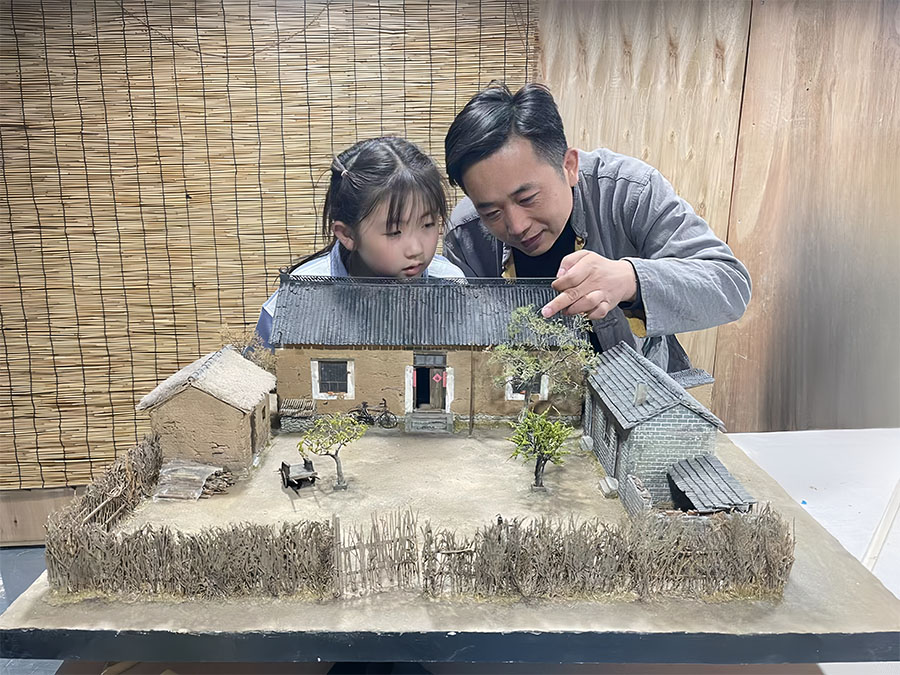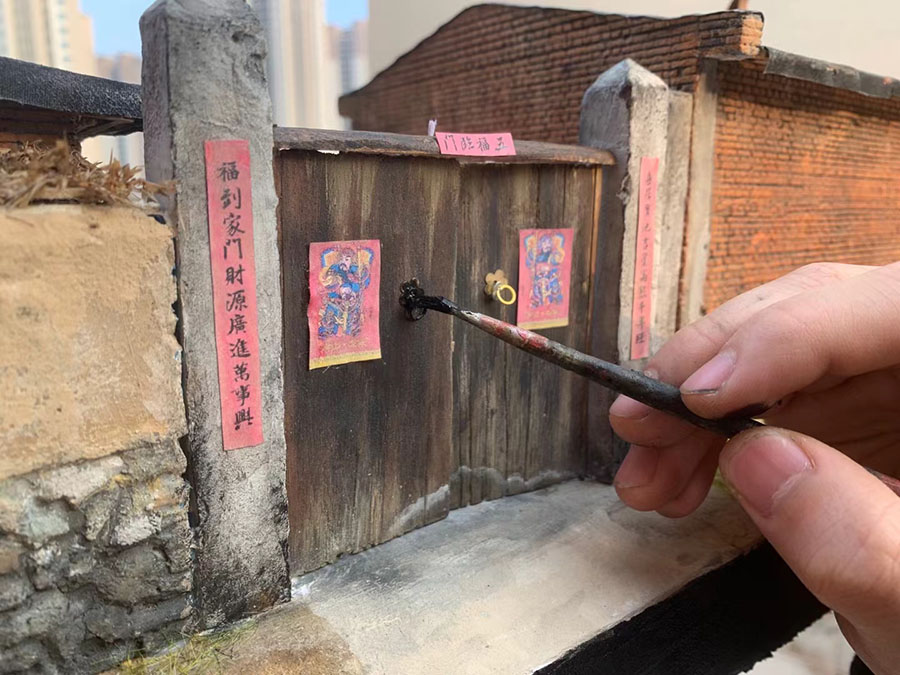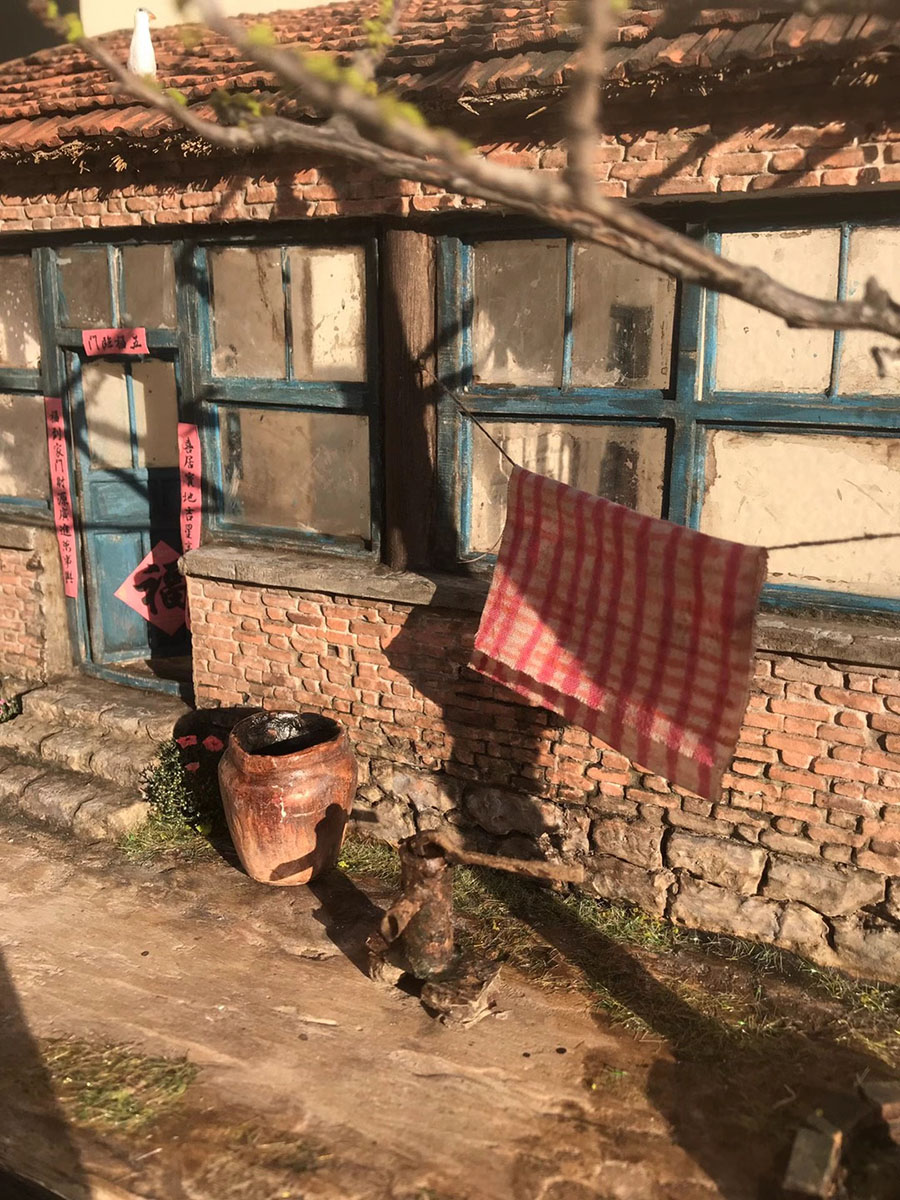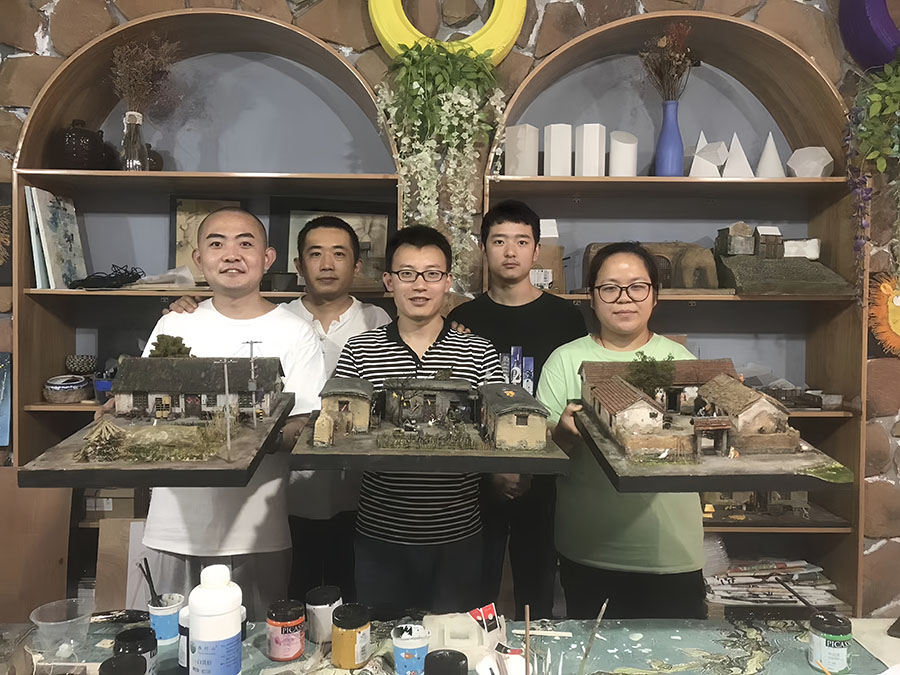Small is Beautiful

A detailed scale model brings to life a village courtyard scene from yesteryear. [Photo provided to China Daily]
Master craftsman keeps memories of bygone rural life alive through his miniature models, Hou Chenchen reports.
The paper edges of faded red Spring Festival couplets curl on the timeworn wooden door, while a gnarled persimmon tree laden with its golden fruit stands near the entrance.
Close by, a broom made of pine branches leans casually against the peeling, white wall of the house with patches of weathered, gray bricks exposed.
The serene scene can generate nostalgic feelings for many Chinese residents who have lived in a traditional, rural Chinese courtyard dwelling — until a huge hand interrupts any such bucolic reminiscing as it carefully places a fingernail-sized stone well in the yard.
Li Yizhong, an artisan of miniature items, is putting the final touches on the scale model of a folk house. As a pioneer of the art, the 40-year-old from East China's Shandong province is dedicated to replicating traditional dwellings in China, creating miniatures of the homes across the country.
Miniature art refers to works created on a scale significantly smaller than their conventional size. Scale modeling, a subset of miniature art, involves the meticulous crafting of small replicas of three-dimensional sculptures or architectural projects.

Li Yizhong (second from left) and his apprentices show some of their work in Li's studio in July 2020. [Photo provided to China Daily]
Li, who majored in sculpture at Shandong College of Arts, is behind the first scale model studio of its kind in the country exclusively dedicated to replicating traditional Chinese folk houses.
"Miniature modeling began early in the West but it primarily focuses on engineering structures and natural landscapes, like trains or the Grand Canyon," said Li.
Li's works are mostly 1:30 scale models that replicate elements within a Chinese rural courtyard, including the main house, plants, domestic animals, farm tools, interior furnishings and various other natural and man-made surroundings.
"Completing a model with all the accessories usually takes one to three months. The time depends on the complexity of the work," Li said.
Customers who come to Li with requests for miniatures usually provide photos of their houses from different angles, he said. But the challenge arises when they cannot supply photos and Li has to create a model based solely on their descriptions and memories of their buildings.
"Some individuals have vacated their rural houses and they have no images of the place. Some museums with exhibitions of villages also want to represent their historical development but do not have any relevant material for me to work with. I have to replicate the items through historical texts," he said.
The initial step is to craft a 3D model with computers, then refine the model until the customer recognizes it as an accurate representation, Li said. After, he focuses on the "texture" of the accessories.
The creation of accessories in the courtyard demands considerable patience. For example, to craft the branches of the palm-sized persimmon tree, Li used 521 pieces of 0.02-millimeter light iron wires.
He uses "composite materials" to put together the folk house and courtyard. Dozens of materials have been used, including common substances such as wood, metal, mud and plastic.

Li has a steady hand as he paints the latches of a tiny gateway. [Photo provided to China Daily]
Local knowledge
Folk houses in China vary across different regions, especially in three aspects: building, plants and farm tools.
"For the houses in North China, I use mostly extruded polystyrene foam, while for those in Southwest China I use wood boards."
Matching materials with the authentic texture of the real structures is paramount, Li said.
"A singular material cannot capture the diverse range of textures, as each material has its inherent limitations. We try to grasp the uniqueness of each material to aptly represent various objects," he said.
"Collecting trash" is part of Li's daily routine, he said jokingly.
"I sometimes use discarded transparent plastic boxes to craft windows. As for the window screens, my wife's silk stockings are really suitable," he said.
"The greatest challenge is to find appropriate materials for making plants, particularly trees with leaves and small fruit, like date trees."
It is extremely difficult to replicate the texture of such natural elements because the subjects vary in different seasons and under different lighting conditions, he said.
Li said he has actually collected twigs to see if their texture, color, cracks and other characteristics can be applied to his miniature scenes.
"The wooden sticks available in the market are always in a straight and upright form, yet we prefer sticks with subtle, natural curves, authentic characteristics that we can retain," Li said. "The essence of the miniature is its faithful replication."

Craftsman Li Yizhong holds aloft a miniature model of an ice cream seller's bicycle. [Photo provided to China Daily]
Remembering lives
Placing his miniature dwelling model in a sunlit, outdoor setting, the branches of Li's golden persimmon tree sway gently, responding to the breeze with a subtle quiver. Its shadows dance gracefully across the weathered wall of the house.
"A miniature constitutes a form of multi-dimensional presentation with a high degree of realism. Compared to a house in photographs, it delivers a more powerful visual impact and sense of space," Li said.
Li began sharing his folk house scale models via social media platforms in 2018 and two years later, his videos went viral. "The pandemic compelled us to stay home, reflect on the past, and connect with our emotions," he said.
"Each folk house carries with it the history of a family and witnesses the laughter and tears of generations. It carries the profound weight of a vanishing family culture in China," Li said.
His career as a miniatures artisan also exposes Li to the rich emotions and memories of many people.
One of his customers could not hold back tears when she shared stories of her childhood. Her house was expanded, room by room, throughout the years, as her father tirelessly saved money. She left the village eventually and the house was demolished, leaving cherished family memories buried deep within her heart.
Another man in his 40s was moved to tears after he saw the model of a rural classroom, complete with its wooden chairs and dusty blackboards. "Perhaps the classroom helped him recall memories of his youth and first love," Li said.
Amid China's large-scale urbanization and rapid development, the memories of many residents have been woven into the collective experience of a generation, with a large population moving from villages to towns and cities, leaving behind abandoned folk houses in their minds.

A courtyard created by Li is so detailed that it even has laundry drying on a clothesline. [Photo provided to China Daily]
Building history
"Folk houses in North and South China were similar during the 1960s but by the 1980s and 1990s, people in the South were some of the first to benefit from China's opening-up, and their housing conditions improved a lot," Li said as he emphasized how the scale models catch the "pulses of history".
A 14-year-old girl, one of the many children in the country whose parents left their rural houses to work in the cities, reached out to Li, requesting him to recreate her home where she was raised by her grandmother as she herself subsequently moved to an urban area, he said.
In 2020, Li set up a center in Jinan, Shandong province to impart his miniature-making skills. More than 300 apprentices, ranging in age from 16 to 79, have successfully learned the basics of the craft, he said.
Two sisters, retirees in their 50s, are among those who spend time in Li's studio to craft their own folk home and remember their childhood.
"People can immerse themselves in crafting their own home. It's not tedious because they create it detail by detail, recollecting sweet and bitter memories gradually," he said.
Some of his trainees keep the model themselves while others send it to their children, allowing them to see the places where their parents grew up.
"It is a kind of inheritance," Li said. "Family ties have deep roots in China, but now we are gradually losing it. Some young people even find it hard to understand why a poor house can arouse such deep emotions. Some have asked me if it is a house for hamsters."
Li said he now plans to replicate the entrance to the village where he grew up. "In our village, my father worked as a builder of rural houses, constructing homes for others. Now, I've inherited his work by building homes — but in miniature, in memories."

Li discusses one of his models with his daughter in 2022. [Photo provided to China Daily]